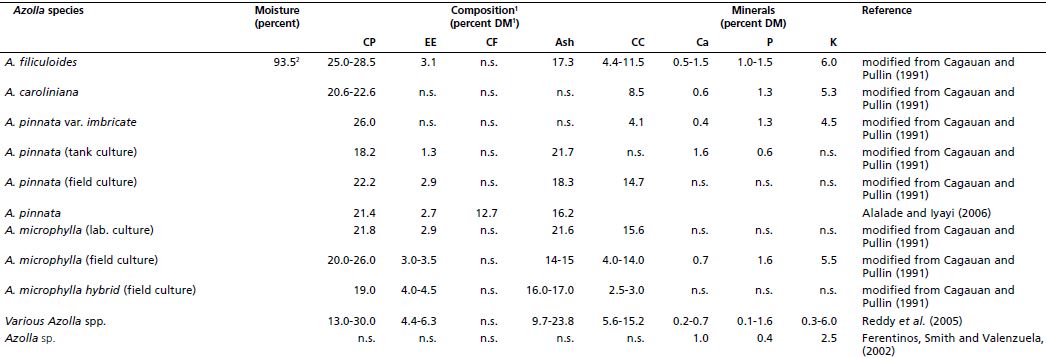2.3. Production
Multiplication of Azolla in nature and in the laboratory is entirely through vegetative reproduction. However, sexual reproduction, which is essential to the survival of the population during temporary adverse conditions also, occurs. When Azolla fronds reach a certain size depending on the species and the environment, generally 1 to 2 cm in diameter, the older secondary stems detach themselves from the main stem as a result of the formation of an abscission layer, thus giving rise to new fronds. This is the most usual mode of multiplication.
Sherief and James (1994) have described a simple Azolla nursery method for its large-scale multiplication in the field for Indian farmers. The field for an Azolla nursery must be thoroughly prepared and levelled uniformly. It is divided into different plots by providing suitable bunds and irrigation channels. Water is manipulated at a depth of 10 cm. Ten kg of fresh cattle dung mixed in 20 L of water is sprinkled in each plot and an Azolla inoculum of 8 kg is introduced to each plot. Superphosphate (100 g) is applied in three split doses at intervals of four days as a top dressing fertilizer. For insect control, furadone granules at 100 g/plot are applied seven days after inoculation. Fifteen days after inoculation, Azolla is harvested. From one harvest, 40-55 kg of fresh Azolla is obtained from each plot.
Reddy and DeBusk (1985) reported the yield of Azolla (A. caroliniana) to be 10.6 t DM/ha/year in nutrient non-limiting waters of central Florida, USA.
According to Ferentinos et al. (2002) the nitrogen fixation capacity of Azolla was found to vary from 53-1 000 kg/ha with a dry matter production of 39-390 tonnes/ha, in crop cycles of 40-365 days. The linear growth phase is usually between 6 and 21 days and is characterized by low lignin and cell wall fractions. Due to its high lignin content (20 percent), nitrogen is released slowly from the plant initially, with about two-thirds released on the first 6 weeks after application. Under flooded conditions, 40-60 percent of the available N is released after 20 days and 55-90 percent within 40 days after application
Reddy et al. (2005) described the production of Azolla in earthen raceways (10.0 m x 1.5 m x 0.3 m) in CIFA, Bhubaneswar. 6 kg of Azolla was inoculated in each raceway. 50 kg single super phosphate and pesticide (1-2 mg/l) were applied and a water depth of 5-10 cm was maintained. 18-24 kg/raceway/week was produced. About one tonne of Azolla could be harvested every week from water spread area of 650 m2, with a phosphorus input-nitrogen output ratio of 1:4.8.
Table 2.2
Chemical analyses of various Azolla species

1 CP = crude protein; EE = ether extract; CC = crude cellulose; Ca = calcium; P = phosphorus; K = potassium
2 Data obtained from Tacon (1987)